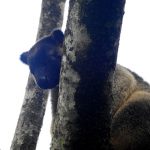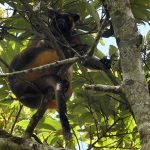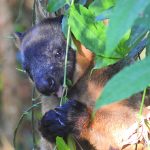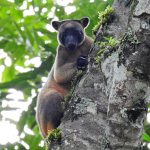LUMHOLTZ TREE-KANGAROO
Lumholtz’s Tree-kangaroo
Hidden high in the canopy of north Queensland’s rainforests, Lumholtz’s tree-kangaroo moves with a calm, careful grace. It is one of Australia’s most unusual mammals: a kangaroo that has abandoned the open ground for a life among leaves, branches, and moss-covered trunks.
1. Who is Lumholtz’s tree-kangaroo?
- Scientific name:
Dendrolagus lumholtzi - Common name: Lumholtz’s tree-kangaroo
- Family: Macropodidae (the kangaroo and wallaby family)
- Status: Listed as Near Threatened in Queensland; of conservation concern due to habitat loss, vehicle strikes and dog attacks.
Named after the Norwegian explorer Carl Lumholtz, who worked in Australia in the late 1800s, this species is one of only two tree-kangaroo species found in Australia (the other is Bennett’s tree-kangaroo of the Wet Tropics to the north).
2. What does it look like?
Imagine a compact, muscular kangaroo shrunk down and reshaped for life in trees.
Key features
Size:
- Body length: ~48–65 cm
- Tail length: ~60–75 cm
- Weight: ~7–11 kg (males often heavier than females)
Fur and colouring:
- Dense, woolly fur that helps shed water in the cool, misty rainforest.
- Generally dark brown to charcoal on the back.
- Paler belly, often creamy or light brown.
- Face often slightly lighter, with small, rounded ears.
Tail:
- Very long, thick, and not prehensile (it cannot grip like a possum’s tail).
- Used as a counterbalance when moving through the trees and when climbing.
Limbs:
- Forelimbs: Strong, with long, curved claws for gripping bark and branches.
- Hindlimbs: Shorter and more compact than a ground kangaroo, designed for climbing and controlled leaping rather than long-distance hops.
- Flexible ankles that allow the animal to grip tree trunks and move vertically.
If you saw one up close, you might notice its fur looks almost velvety and matt, like a thick winter coat, and its strong front claws are more like those of a possum or a tree-climbing mammal than a typical kangaroo.
3. Where does it live?
Range
Lumholtz’s tree-kangaroo has a very restricted range:
- Endemic to north-eastern Queensland, Australia
- Mainly on the Atherton Tablelands and surrounding highlands in the Wet Tropics region
- Prefers upland and montane rainforest, often above 600 m elevation
Habitat
- Dense tropical and subtropical rainforests
- Especially favours older forests with:
- Tall, continuous canopy
- Abundant vines and complex vertical structure
- Plentiful food trees
They are sometimes seen at the forest edge near rural properties, especially where forest meets pasture. When they come down to the ground to cross a clearing or road, they are at their most vulnerable.
4. A day in the life: behaviour and lifestyle
Mostly nocturnal and crepuscular
Lumholtz’s tree-kangaroos are usually:
- Most active at night and around dusk and dawn
- Resting during the day, often high in the canopy
In the daytime you might find one hunched in a leafy fork of a tree, almost motionless, looking like a dark bundle of fur against the bark.
Movement: from leaping to climbing
Their movement style is one of the most fascinating things about them.
In trees:
- They climb vertically using strong forelimbs and claws.
- They make short, deliberate leaps from branch to branch, using the tail to balance.
- They are generally cautious, not spectacular leapers like possums or arboreal gliders.
On the ground:
- They can still hop like other kangaroos, but with a rather stiff, upright posture.
- On steep ground they may move in a slower, bounding walk or careful hop, especially when crossing between forest patches.
Watching one move from a tree to the ground is like seeing two animals in one: a tree-dweller that suddenly remembers it is related to kangaroos.
Social habits
- Generally solitary or in loose associations.
- Home ranges of individuals can overlap, and they may tolerate one another if food is abundant.
- Communication is subtle – through scent, soft sounds, and body language, rather than loud calls.
They do not form large mobs like many ground-dwelling kangaroos and wallabies. Their world is quieter, more secluded, mostly shared with birds, possums, and insects in the upper layers of the forest.
5. What do they eat?
Lumholtz’s tree-kangaroos are primarily folivores – leaf-eaters.
Diet
- Leaves of many rainforest trees and vines
- Occasionally:
- Fruit
- Flowers
- Young shoots
They are selective feeders, choosing:
- Young, tender leaves when available (easier to digest, less tough)
- Specific plant species that suit their digestive system
Their stomach is adapted to handle fibrous, sometimes chemically defended leaves, a bit like other macropods, but tuned to the rainforest menu rather than dry grasses.
6. Reproduction and life cycle
Breeding
- Can breed at various times of the year, but local conditions and food availability can influence timing.
- Like all macropods, their young are called joeys.
Raising a joey
Birth:
- The joey is born extremely tiny, hairless, and underdeveloped.
- It climbs into the mother’s pouch and attaches to a teat.
Pouch life:
- The joey remains in the pouch for several months, growing fur and slowly opening its eyes.
- It later begins to peek out, then makes short excursions out of the pouch before retreating for safety.
Emergence:
- Once too big for the pouch, the young will ride on the mother’s back or stay close to her in the canopy, learning which branches to trust and which foods to choose.
Tree life adds an extra layer of risk. A young tree-kangaroo must learn careful balance and muscle control; a bad misjudgement could mean a long fall.
7. Predators and threats
Natural dangers
Historically, likely predators included:
- Large pythons
- Possibly raptors (large birds of prey) targeting young individuals
However, today, human-related threats are far more significant.
Modern threats
Habitat loss and fragmentation:
- Clearing of rainforest for agriculture, housing, and infrastructure reduces available habitat.
- Forest fragments are often separated by open paddocks and roads, forcing animals to descend and cross exposed ground.
Vehicle strikes:
- Tree-kangaroos sometimes cross roads at night or early morning.
- Their dark fur and slow, deliberate movement can make them hard for drivers to see in time.
Dog attacks:
- Domestic and feral dogs can injure or kill tree-kangaroos, especially when the animals are on the ground or in low trees near homes and farms.
Climate change:
- Changes in rainfall and temperature can affect highland rainforest.
- Range-restricted species like Lumholtz’s, which rely on cooler upland forests, have fewer options to move if their climate envelope shifts upwards and shrinks.
8. Conservation and care
Protection efforts
- Much of their remaining habitat falls within the Wet Tropics World Heritage Area, which offers some legal protection.
- Wildlife carers and local groups rescue and rehabilitate injured animals, especially from road accidents and dog attacks.
- Research projects track tree-kangaroos to understand:
- Home range sizes
- Movement patterns
- Habitat needs
How people can help (especially locally)
- Drive carefully in rainforest regions, particularly at night and near forest edges.
- Keep dogs under control, especially at night or near forested areas.
- Support habitat restoration projects that link fragments of rainforest so animals can move with less need to cross open ground.
- Back organisations that protect the Wet Tropics and other rainforest habitats.
Every intact patch of forest, every safe wildlife crossing, makes a difference to animals that cannot easily leave their shrinking homes.
9. Experiencing Lumholtz’s tree-kangaroo
What is it like to encounter one?
In the upland rainforest, the air is cool and heavy with the smell of damp earth and leaf litter. Drops of water cling to lichen on the branches. You hear the steady call of a fruit-dove, the distant rush of a creek.
At first, the tree-kangaroo is invisible. Only when you slow down and your eyes adjust to the patterns of light and shadow do you notice:
- A dark, compact shape nestled in a fork high above
- A slow movement – the turn of a head, the gentle lift of a forepaw
- The thick tail stretched down the trunk, like an extra branch
There is a stillness about this animal. It watches you, but without panic, as if it has weathered many days of wind and rain in this same patch of forest.
10. Why Lumholtz’s tree-kangaroo matters
Lumholtz’s tree-kangaroo is:
- A symbol of Australia’s rainforest evolution – a kangaroo that has adapted to the trees.
- A key herbivore that shapes vegetation by browsing specific plants.
- A flagship species for the protection of highland rainforest on the Atherton Tablelands.
By protecting this one quiet, tree-dwelling kangaroo, we also protect:
- Countless birds, insects, frogs, bats, and plants that share its habitat
- Cool, moisture-rich forests that store carbon and feed streams.
Photo Gallery
Sharon:
This was a wonderfully, rare, experience watching a juvenile Lumholtz Tree Kangaroo start dispersing into his new Home Range.























